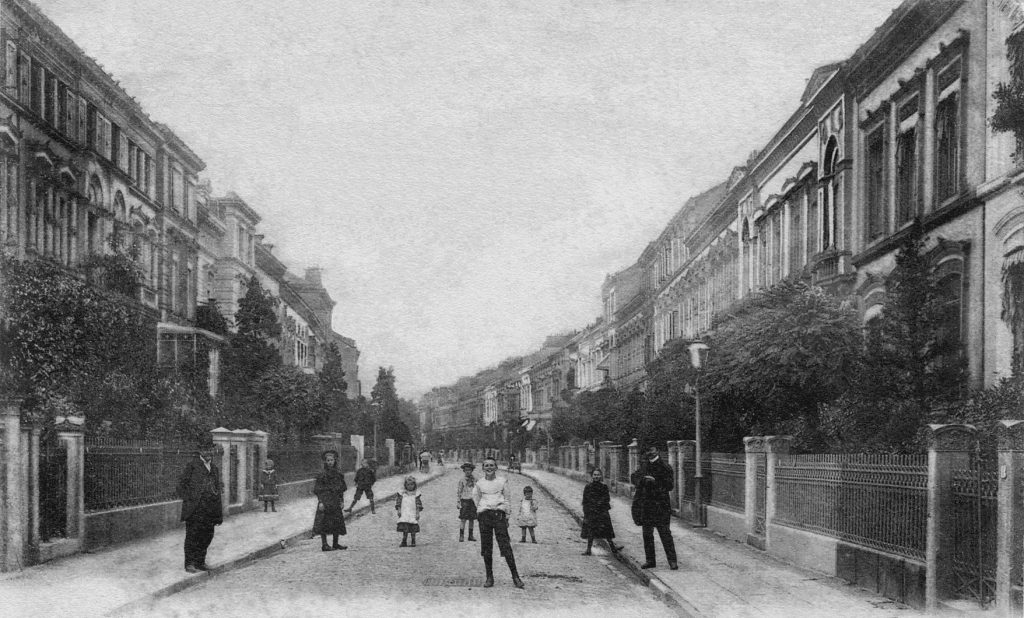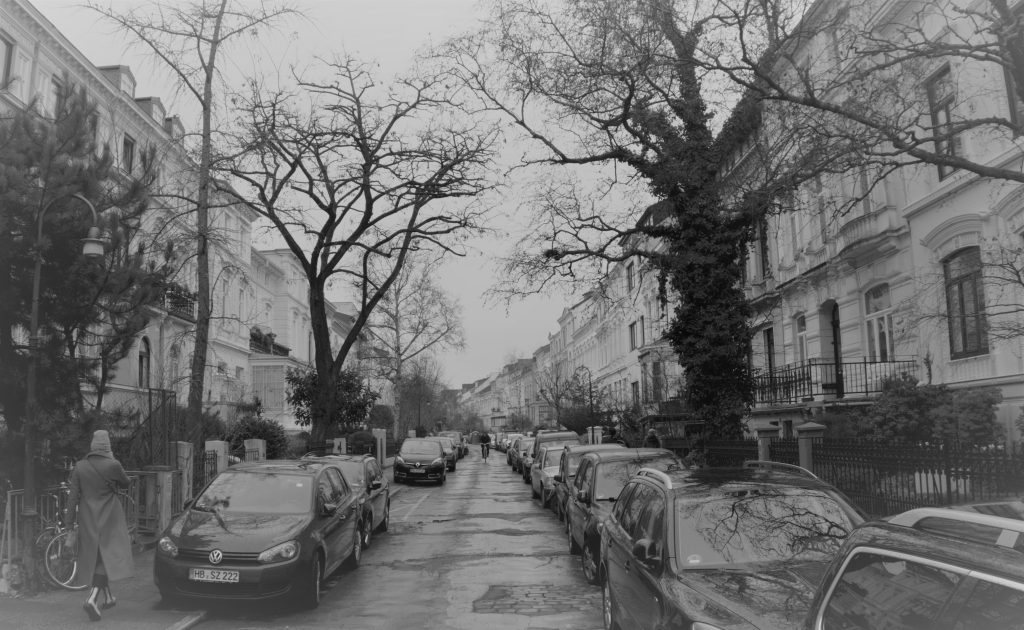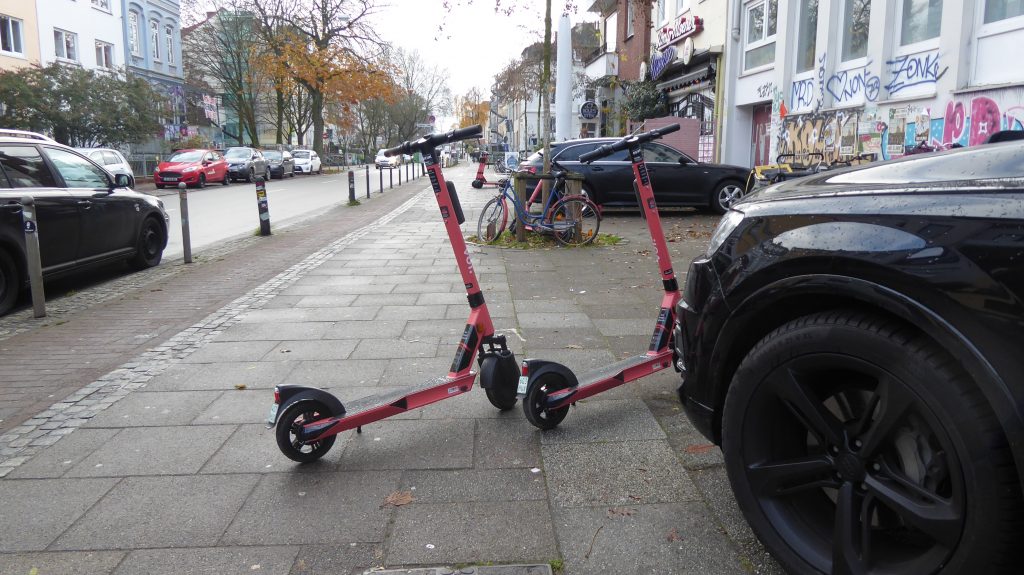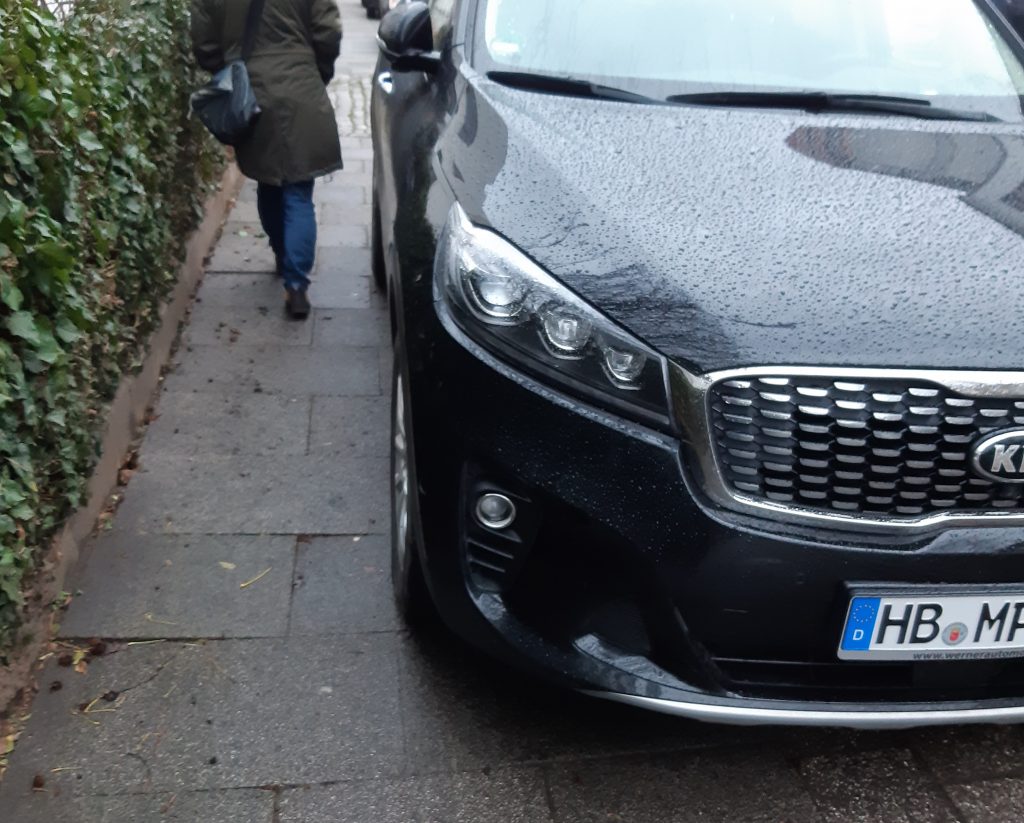Part 1 : The legal Situation on Bremen’s Streets
Public space is always a scarce commodity in cities that have grown over time without central planning. Ever more, and ever bigger, vehicles are competing for the same amount of space. At the same time, private automobiles are continuing to push other modes of transport out of this public space. Currently, political as well as legal resistance to this situation is growing, supported by environmental organisations such as BUND, NABU, citizens‘ and neighbourhood initiatives, and transport organisations such as ADFC, VCD; Fuss e.V., Forum for Transportation Transformation („Forum Verkehrswende“), Autofreier Stadttraum („Auto Free City Space/City Dreams“) and Coalition for Transportation Transformation (“Bündnis Verkehrswende“). In addition, many citizens have filed suit against the city-state for its lack of action against vehicles parked illegally on sidewalks. This problem is further complicated by electric scooters parked on sidewalks In the summer of 2020, a visually impaired man was seriously injured in Bremen when he tripped over an electric scooter. He has filed suit against the city-state for not protecting him from injury.
Parking on the sidewalk in Mindener Strasse in Peterswerder in Bremen (foto: Olaf Dilling)
The problem is well known: on sidewalks where motor vehicles are allowed to park, it is almost impossible to pass with a buggy, a walker, or even a wheelchair. In Bremen‘s “Traffic Development Plan“ which was approved by Bremen‘s Parliament in 2014, parking on sidewalks in the neighborhoods of Östliche Vorstadt, Schwachhausen, Neustadt, Woltmershausen, Walle and Findorff was identified as a serious problem. As a result, and also as a result of cobblestone paving on roads there, particularly in the Östliche Vorstadt, this report called for action to ensure accessibility. Almost nothing has been done to improve accessibility for pedestrians or mobility-impaired people since then.
But the problem isn’t limited to sidewalks; wheelchair ramps at intersections, and the intersections themselves, are often parked full by motor vehicles so that safe passage is difficult. Having to squeeze between parked cars to walk down the sidewalk or cross the street is a challenge and endangers those who are forced to do so. In addition to this, rubbish bins or bicycles are often stored on the sidewalk so that the already limited sidewalk space remaining becomes completely impassable. The tactile orientation system that is intended to help blind people navigate is regularly blocked by parked vehicles, including company cars, but also bicycles and e-scooters. As will be discussed below, this situation, which is not just an occasional occurrence but a massive and constant problem, infringes upon mobility rights and the right to equal participation in society.
Over the course of these three articles our blog will describe the planning and legal history behind this situation:
- In this first article, part 1, we offer a brief overview of city planning in Bremen as well as of the right to equal participation in society
- In part 2, we’ll explain how this right is anchored in the UN Conventions on the Rights of Persons with Disabilities as well as the ban on discrimination laid out in Germany’s constitution, in federal law and in state law
- In part 3, we shall explore the important questions around accessibility in public transportation.
I. The historical background of the built environment in Bremen
Most neighbourhoods which are closer to the city center of Bremen are built on peaty soil that was once bogland. Thus these neighbourhoods are also potentially in danger of flooding through storm surges. As a result, the streets in these neighbourhoods were built up to act as dams in case of flooding, something that can be seen in the considerably lower level of most back yards when compared to street level. Since the construction of these embankments was both expensive and time-consuming, the streets are relatively narrow, and are generally based on the minimum width of 10 meters that was laid out in the building codes of 1883. The majority of streets in these neighbourhoods were built before the middle of the 20th century and are largely characterised by the typical “Bremen terraced Houses.“
 Lots of space for people, Mathildenstrasse in Bremen-Mitte, end of the 19th Century
Lots of space for people, Mathildenstrasse in Bremen-Mitte, end of the 19th Century
These streets are typically about 6 meters wide from curb to curb, with a shoulder which includes sidewalks of a maximum of 2 meters in width. Over the course of the second half of the 20th Century, more and more motor vehicles began creeping onto the sidewalk to park. This practice was partially legalized through special signs, but much of this illegal parking was and continues to be tolerated by the police and other regulatory officers. Nothing is done. Thus the space for pedestrian traffic is increasingly shrinking through ever-larger motor vehicles being illegally parked on sidewalks.
 Vehicles parked on the sidewalk on both sides of Mathildenstrasse, Bremen-Mitte, 2021
Vehicles parked on the sidewalk on both sides of Mathildenstrasse, Bremen-Mitte, 2021
Above all else, this is a burden for mobility-impaired people who need canes, walkers, or wheelchairs, but even more so for visually-impaired people. Frequently, even the 80-90 centimeters a wheelchair user needs to be able to move are not even available; sidewalks are also made narrower through infrastructure such as electric boxes, street lights and signposts as well as bike parking. This problem is compounded by the regular use of the sidewalks for the placement of large waste dumpsters for construction sites as well as the weekly setting out of household waste bins so that the remaining space on sidewalks is often less than 1 meter. This often makes the sidewalks unusable so that pedestrians and wheelchair users have to walk on the roadway where cars travel. It is thus impossible for pedestrians approaching in opposite directions to pass each other, as is – theoretically – guaranteed even in those sections of the vehicle code which permit motor vehicles parked on sidewalks. Given the current need for social distancing which the pandemic situation requires, the reality that pedestrians constantly need to move to the other side of the street or even walk on the roadway to avoid closer contact, it is clear that this is a problem.
This situation is not just problematic from the point of view of transportation politics, but also given the background of legal rights to equal access to mobility codified in international, national, and state laws. Germany signed the UN convention on disability rights, and the German Constitution also guarantees freedom from discrimination and the right to equal participation in society.
II. Foundations in higher legal instances
- UN Convention on the Rights of Persons with Disabilities
A central foundation for accessibility rights is the Right to Mobility in the UN Convention on the Rights of Persons with Disabilities. According to Article 20 of this Convention, signatory states, which include Germany, are required to take measures to ensure the greatest possible individual freedom of movement and independence for people with mobility impairments.
More specifically, Article 9 Section 1 reqiures all signatory parties, of which Germany is one, to implement methods to guarantee accessibility. The recognition and removal of barriers to mobility are part of this law; under Sentence 1, Number 1 in the same Article, this duty under the law explicitly also applies to streets.
These human rights must, thus, first and foremost be implemented by lawmakers. Here, the author will explain why this implementation in German law has already occurred, meaning that in a court of law, plaintiffs can directly base their claims on existing German laws. However, courts must also keep the UN convention in mind in their decisions.
2. Prevention of discrimination and right to participation in society in Germany‘s constitution (basic law)
The German Basic Law also provides sufficient reasons why access to fundamental transportation infrastructure should not be denied to mobility-impaired citizens. Article 3, Paragraph 2, Sentence 2 of the German Basic Law prevents discrimination against disabled people. This not only forbids any actions of the state that might disadvantage individuals, but also any related disadvantages that may arise, such as the designation of parking spots that limit the mobility of these individuals in any way. Furthermore, the de facto hinderance of this accessibility by other individuals, such as the massive numbers of illegally parked private motor vehicles, falls under the responsibility of the state to protect its citizens. When illegally parked automobiles hinder the ability of others to shop for groceries or to get to the nearest bus stop, state institutions must take action.
In addition to the existing discrimination taking place, the right to move and act freely which is legally guaranteed in the Basic Law (Article 2 Paragraph 1) is being injured here. Mobility impaired individuals are being discriminated against through concrete actions as well as through the massive hindrances which, de facto, directly arise from the behavior of other individuals. Furthermore, the guarantee of a minimum of independent mobility must be guaranteed, because mobility is required in order to take part in the political and cultural life of society. The German Constitutional Court handed down a decision on this right based on Article 1, Paragraph 1 as well as Paragraph 20 of the Basic Law (Decision from 18 July 2012 – 1BvL 10/10)
3. Approaches in German Federal Law
The Law of Accessibility has been implemented through the Federal Government, for example in Paragraph 8, Section 5, Sentence 1 of the German Equal Opportunities for People With Disabilites Act; public roads, spaces, and streets, including sidewalks, as well as public transit and access to public transit, must be made accessible.
In addition, this Law has also made an imprint on administrative guidelines for traffic codes, above all, the guidelines for the approval of motor vehicles parked on sidewalks. This, however, affects transportation legislation, which will be dealt with in detail in the next article following this one (Part B of this three part series: enforcement of the law for equal access in transportation legislation). OK TO HERE FEB 1
III. Accessibility in Transport and Social Law in Bremen
In the State of Bremen, the requirements of the UN Convention on the Rights of Disabled People were directly implemented into law. By doing so, Bremen had the ambition of being a special role model, within the context of the State Action Plan, which began in 2014. According to the Foreword of this plan by Social Minister Anja Stahmann, Bremen should continue to be a role model in the implementation of human rights, and guarantee the full, equal, and independent participation of people with disabilities.
However, it is important to note that the regulations for the use of existing roads are a matter of traffic law. Regulating and enforcement of parking falls under paragraph 12 of the StVO; legislative power over these laws falls under the responsibility of the federal government, while enforcement is a matter for each federal state.
In contrast, the states themselves are responsible for traffic legislation: generally, this means for rules governing zoning, construction and maintenance of streets The relationship between roads and transport legislation is relatively complicated: as road traffic law, which is federally governed, takes precedence, but since transport legislation affects the creation and zoning of transport spaces, it creates concrete guidelines for what can be governed by transport legislation in a particular context (the so called “reservation of the rights over transportation“), for example so that a pedestrian zone cannot simply be opened to motorized traffic by erecting a sign permitting this.
1. Laws in Bremen: Equal Opportunity for Persons with a Disability and Road Construction
The Law for Accessibility on Public Streets has been implemented in Paragraph 8, Section 5 of the State of Bremen‘s Disability Rights Law in the areas of construction and transportation. This takes the form of binding regulations that public roads, spaces, and streets are to be made accessible following the relevant laws.
In addition, Paragraph 10, Section 1, Sentence 2, Part 2 of the State of Bremen’s Transportation Legistlation (?OK?) was inserted into the implementation of the UN Convention, so that the needs of mobility impaired and other disabled people can be takten into account with as much accessibility as possible.
2. Guidelines for Accessible Design
a) Diversity of Barriers to Accessibility
The concrete measures that are needed to guarantee accessibility are outlined in Bremen’s Guidelines for the Accessibility of Built Structures (OK?) this raises the question as to what accessibility means. This question is as difficult to answer as the question as to which different kinds of barriers prevent people from being mobile. In general, as with other questions around inclusion, the point is to do justice to peoples‘ different needs.
Thus, the Guidelines include an entire set of different demands that transportation infrastructure has to meet, including the following sets of questions:
- Creation of sidewalks, also with regards to built-in components, surfacing, grading and thresholds
- Tactile orientation assistance for blind people, also with special attention to public open spaces
- Creation of crossing opportunities
- Creation of stairs and ramps and other technical aids in overcoming height differences
- Disabled parking spaces
- Access to public transport
- The accessible construction of cycle infrastructure
- Construction of sports infrastructure and playgrounds
Given the large amount of potential barriers that can only be determined when consulting those actually affected, it is important to include those affected in planning. Thus, such public processes must include the State Representative for People with Disabilities both in creation as well as implementation. (OK?)
b) Sidewalks Require Particular Attention
In light of the well-known problem described at the beginning of this article with already narrow sidewalks being parked full of motor vehicles, rules governing sidewalks are particularly important. This includes a construction standard of a minimum of 1.80 meters. „Protective strips“ on the street side of the kerb, which separate it from traffic lanes, are also considered part of the sidewalk, but are not included in these measurements.
 The space needed for pedestrian traffic (Image from Leon Baur following RASt 06, S. 29)
The space needed for pedestrian traffic (Image from Leon Baur following RASt 06, S. 29)
Generally these “protective strips“ are no more than 70cm wide, 20 cm on the side of the houses and 50 towards the street. These requirements are actually rarely met in Bremen as a result of the city planning characteristics described above.
 Electric Scooters on Sielwall, (Foto: Beatrix Wupperman)
Electric Scooters on Sielwall, (Foto: Beatrix Wupperman)
The width of the protective strips is dependent on local characteristics, for example, when low enclosures such as walls or fences cause them to be narrower. In the case of common obstructions such as parked bicycles, garbage bins, or electrical boxes the protective strips need to be made wider. (?OK) Typically, this combination of various obstructions leads to sidewalks being unusable. For example, garbage bins are often placed near fences or at the outside walls of houses, something that is actually prohibited according to Paragraph 17, Section 1 of the Bremer Law Governing the Disposal of Waste where they should be placed on the road edge, which is usually – often illegally – parked full with private vehicles.
With the definition of an accessible sidewalk of 1.8 meters, the Bremen rules are actually in conflict with the relevant technical manual, the „Guide for Accessible Transportation Infrastructure“ (OK?), which states that a minimum width of 2 meters for the unproblematic passing of two mobility-impaired people. In fact, allowing for enough room on each side for these people to pass safely actually requires a width of 2.7 meters.
Furthermore, all these guidelines and technical manuals were designed before Corona, so social distancing to prevent infection was not included in these measurements. However, these issues will continue to play a role in the near future.
Not accessible: Sidewalk in Achimer Strasse in Bremen-Peterswerder (Photo: O. Dilling).
A width of 1.8 meters (plus protective strips) should, according to Bremen’s Guidelines for Accessibility, only allowed to be reduced when this is impossible to change as a result of existing structures, property lines, or mandatory rules for the cross-section design of streets. If they are not to be in conflict with the UN convention and the Bremen Accessibility Law, these exceptions are to be defined very narrowly. In particular, the planning of (more) parking spaces does not count as a mandatory rule for the cross-section design of streets. In fact, this mandatory cross-section design includes moving traffic, but not parked traffic. According to existing technical manuals for transportation planning, streets should be planned „from the outside towards the inside,“ in other words, pedestrian and cycle traffic should get enough space, and, only when this is assured, should the needs of private individual motor vehicles be taken into account.
Against this background, the exception granted in Bremen’s guidelines should be seen at best for the space requirements of flowing traffic, especially for emergency vehicles, for example in a one-way street. For provisioning or logistics vehicles, but especially for fire trucks and ambulances, the minimum width of the roadway is 3.05 metres.
Conclusion
As an initial conclusion, Bremen’s Law of Accessibility can be said to have been well implemented „on paper.“ The question remains, however, why the situation in individual neighborhoods has hardly changed. This contradiction between an exemplary legislation and a poor execution will be explained in the second part of this series of articles (Part B: Transportation Legislation and Enforcement).

2 thoughts on “Accessibility in Bremen Traffic (Part A: Road Law)”
Comments are closed.